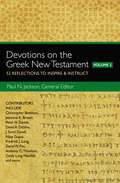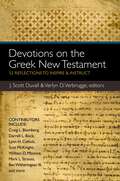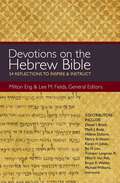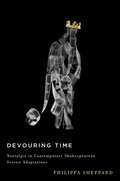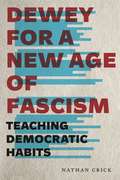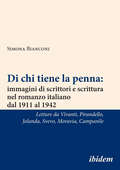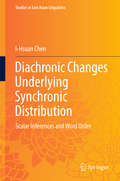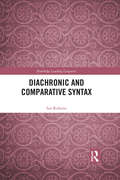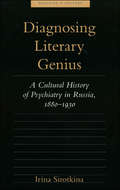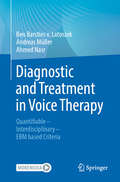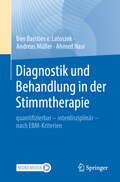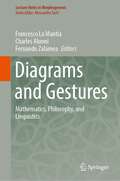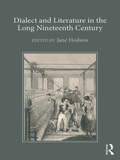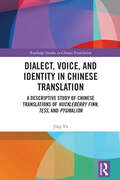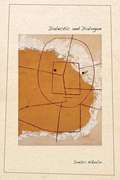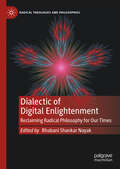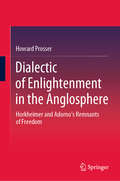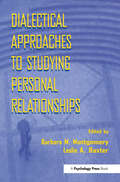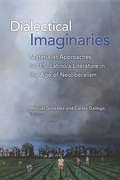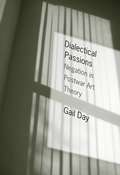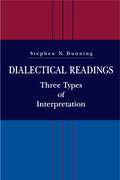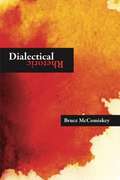- Table View
- List View
Devotions on the Greek New Testament, Volume Two: 52 Reflections to Inspire and Instruct
by Paul Norman JacksonDevotions on the Greek New Testament, Volume Two contains an entirely new set of 52 devotions written by over 25 of today's best biblical language scholars. Contributors include Christopher Beetham, Jeannine K. Brown, Peter H. Davids, David A. DeSilva, J. Scott Duvall, Nijay Gupta, Frederick J. Long, David W. Pao, Anthony C. Thiselton, Cindy Long Westfall, and many more.The main point of each devotion in Devotions on the Greek New Testament, Volume Two comes from a careful reading of the passage in the Greek New Testament, not from an English translation. The authors use a variety of exegetical approaches in their devotions - including grammatical, lexical, rhetorical, sociohistorical, and linguistic - and each devotion closes with a practical application or spiritual reflection.Devotions on the Greek New Testament, Volume Two contains a devotion on every book in the New Testament and can be used as a weekly devotional or as a supplemental resource throughout a semester or sequence of courses. These devotions will inspire you to keep reading and meditating on the Scriptures and find new treasures from the biblical text.X
Devotions on the Greek New Testament: 52 Reflections to Inspire and Instruct
by J. Scott Duvall Verlyn VerbruggeZondervan is known for its excellent resources in biblical languages, and many of our resources encourage professors, students, and pastors to continue to use their Hebrew and Greek Bibles beyond their seminary years.Devotions on the Greek New Testamentcontinues on this path of excellence by introducing these devotions—based on a careful reading and study of the Greek New Testament—written by some of the top Greek scholars of today. Contributors include Scot McKnight, Daniel B. Wallace, Craig L. Blomberg, Mark Strauss, and William D. Mounce, among others.Devotions on the Greek New Testament can be used as weekly devotional or as a supplemental resource throughout a semester or sequence of courses. The main point each devotion offers comes from a careful reading of the passage in the Greek New Testament, not from the English Bible. These authors use a variety of exegetical approaches in their devotions: grammatical, lexical, rhetorical, sociohistorical, linguistic, etc. Each devotion closes with a practical application.
Devotions on the Hebrew Bible: 54 Reflections to Inspire and Instruct
by ZondervanThe main point of each devotion in Devotions on the Hebrew Bible comes from a careful reading of the passage in the Hebrew Bible, not from an English translation—written by some of the top biblical language scholars of today. Contributors include Daniel I. Block, Mark J. Boda, Hélène Dallaire, Nancy Erickson, Karen H. Jobes, Bo H. Lim, Tremper Longman III, Miles V. Van Pelt, Bruce K. Waltke, and Michael Williams, among others. The authors use a variety of exegetical approaches in their devotions—including grammatical, lexical, rhetorical, sociohistorical, and linguistic—and each devotion closes with a practical application or spiritual reflection.Miles Van Pelt, for example, shows that a careful analysis of a grammatical particle in Judges 3:9 elucidates the agent of Israel’s deliverance. Indeed, it is Yahweh who saves! Tremper Longman III explains the role of poetical parallelism in Psalm 1 and highlights how clearly the psalmist invites the reader to introspection, compelling the reader to follow the path of righteousness. And Bo Lim reminds the reader of the biblical precedent for expressing lament. He highlights the poetic artistry of the book of Lamentations, noting its beautiful acrostic, and confirms that both grief and hope provide the rhythm of faith and worship.Devotions on the Hebrew Bible contains a devotion on every book in the Old Testament and can be used as a weekly devotional or as a supplemental resource throughout a semester or sequence of courses. These devotions will inspire you to keep reading and meditating on the Hebrew Scriptures and find new treasures from the biblical text.
Devouring Time: Nostalgia in Contemporary Shakespearean Screen Adaptations
by Philippa SheppardExploring the way filmmakers who adapt Shakespeare&’s plays are fuelled by nostalgia.
Dewey for a New Age of Fascism: Teaching Democratic Habits (Rhetoric and Democratic Deliberation #22)
by Nathan CrickDuring the rise of fascism in the early twentieth century, American philosopher and educational reformer John Dewey argued that the greatest threat to democracy was not a political regime or even an aggressive foreign power but rather a set of dispositions or attitudes. Though not fascist in and of themselves, these habits of thought—rugged individualism and ideological nationalism—lay the foundation for fascism. In this study, Nathan Crick uses Dewey’s social thought and philosophy of education to provide insight into and resources for transforming our present-day politics.Through a close reading of Dewey’s political writings and educational theory, Crick elaborates Dewey’s vision of democratic social life and the education required for its foundation. He shows that for Dewey, communication is essential to cultivating sympathy, intelligence, and creativity—habits of thought that form the core of democratic culture. Crick then lays out a broad curriculum of logic, aesthetics, and rhetoric for inculcating these habits in the classroom, arguing that if we are to meet the challenge of fascism, we must teach these new arts as if our civilization depends on it—because in our new age of politics, it does.Comprehensive and pragmatic, this book presents an experimental model of education that can be applied across the humanities curriculum. It will be of interest to teachers of writing, composition, and rhetoric as well as scholars and students of communication studies, pedagogy, and political theory.
Dewey for a New Age of Fascism: Teaching Democratic Habits (Rhetoric and Democratic Deliberation)
by Nathan CrickDuring the rise of fascism in the early twentieth century, American philosopher and educational reformer John Dewey argued that the greatest threat to democracy was not a political regime or even an aggressive foreign power but rather a set of dispositions or attitudes. Though not fascist in and of themselves, these habits of thought—rugged individualism and ideological nationalism—lay the foundation for fascism. In this study, Nathan Crick uses Dewey’s social thought and philosophy of education to provide insight into and resources for transforming our present-day politics.Through a close reading of Dewey’s political writings and educational theory, Crick elaborates Dewey’s vision of democratic social life and the education required for its foundation. He shows that for Dewey, communication is essential to cultivating sympathy, intelligence, and creativity—habits of thought that form the core of democratic culture. Crick then lays out a broad curriculum of logic, aesthetics, and rhetoric for inculcating these habits in the classroom, arguing that if we are to meet the challenge of fascism, we must teach these new arts as if our civilization depends on it—because in our new age of politics, it does.Comprehensive and pragmatic, this book presents an experimental model of education that can be applied across the humanities curriculum. It will be of interest to teachers of writing, composition, and rhetoric as well as scholars and students of communication studies, pedagogy, and political theory.
Di chi tiene la penna: Letture da Annie Vivanti, Luigi Pirandello, Jolanda, Italo Svevo, Alberto Moravia, Achille Campanile
by Simona BianconiSimona Bianconi explores the creative process of writing, its communicative aspects and the traces of the writer himself in his creations, as well as the effect writing has on the personality of the author.Through the analysis of texts by six outstanding protagonists of the Italian novel in the first half of the 20th century, Bianconi gives answers to fascinating questions that arise about its creators and encourages the reader to experience and understand writing as a revelation of creativity and life.L'invenzione letteraria può dare vita a un secondo scrittore, a sua volta all'opera. A sua volta colui che comunica al di là della parola, che si assume l'importante responsabilità della creazione, che intende lasciare traccia di sé. Da lui nasce il libro, sua sfida, sostegno, tormento; prova unica o reiterata. Come prende forma nel romanzo di primo grado la figura centrale dell'autore? Come si mostra l'immagine ammaliante del suo lavoro nelle storie di lotta e rinuncia, successo e mediocrità presentate? E qual è l'effetto della scrittura sul personaggio - anche nella sua interazione sociale - che, pure tra gravi ostacoli, la elegge tra le vie da percorrere e ne fa il proprio destino?Attraverso la lettura di testi di sei straordinari protagonisti del romanzo italiano nella prima metà del Novecento, ideatori di altrettanti artisti, donne e uomini, si è tentato di dare una risposta ad interrogativi seducenti che il lettore si pone.. In tal modo, penetrando il motivo dell'esperienza della letteratura, si giunge a toccare la scrittura come rivelazione e sigillo di vita.
Di chi tiene la penna: immagini di scrittori e scrittura nel romanzo italiano dal 1911 al 1942 [Italian-language Edition]
by Simona BianconiSimona Bianconi explores the creative process of writing, its communicative aspects and the traces of the writer himself in his creations, as well as the effect writing has on the personality of the author.Through the analysis of texts by six outstanding protagonists of the Italian novel in the first half of the 20th century, Bianconi gives answers to fascinating questions that arise about its creators and encourages the reader to experience and understand writing as a revelation of creativity and life.L'invenzione letteraria può dare vita a un secondo scrittore, a sua volta all'opera. A sua volta colui che comunica al di là della parola, che si assume l'importante responsabilità della creazione, che intende lasciare traccia di sé. Da lui nasce il libro, sua sfida, sostegno, tormento; prova unica o reiterata. Come prende forma nel romanzo di primo grado la figura centrale dell'autore? Come si mostra l'immagine ammaliante del suo lavoro nelle storie di lotta e rinuncia, successo e mediocrità presentate? E qual è l'effetto della scrittura sul personaggio - anche nella sua interazione sociale - che, pure tra gravi ostacoli, la elegge tra le vie da percorrere e ne fa il proprio destino?Attraverso la lettura di testi di sei straordinari protagonisti del romanzo italiano nella prima metà del Novecento, ideatori di altrettanti artisti, donne e uomini, si è tentato di dare una risposta ad interrogativi seducenti che il lettore si pone.. In tal modo, penetrando il motivo dell'esperienza della letteratura, si giunge a toccare la scrittura come rivelazione e sigillo di vita.
Diachronic Changes Underlying Synchronic Distribution: Scalar Inferences And Word Order (Studies In East Asian Linguistics Ser.)
by I-Hsuan ChenThis book deals with synchronic variation in Chinese through a diachronic lens, based on the evidence from a quantitative, longitudinal corpus study. Departing from the traditional analysis in diachronic changes in Chinese linguistics, the cognitive constructionist approach employed in this book is able to capture incremental changes by combining syntax, semantics, and pragmatics. Topics such as word order, focus, scopes of quantifiers, information structure, and negation have been important issues in linguistics, but they are rarely integrated as a whole. The book makes their diachronic interactions available to the students and researchers in the fields of general and Chinese linguistics.
Diachronic and Comparative Syntax: A Comparative History Of English And French (Routledge Leading Linguists #28)
by Ian RobertsThis book brings together for the first time a series of previously published papers featuring Ian Roberts’ pioneering work on diachronic and comparative syntax over the last thirty years in one comprehensive volume. Divided into two parts, the volume engages in recent key topics in empirical studies of syntactic theory, with the eight papers on diachronic syntax addressing major changes in the history of English as well as broader aspects of syntactic change, including the introduction to the formal approach to grammaticalisation, and the eight papers on comparative syntax exploring head-movement, the nature and distribution of clitics, and the nature of parametric variation and change. This comprehensive collection of the author’s body of research on diachronic and comparative syntax is an essential resource for scholars and researchers in theoretical, comparative, and historical linguistics.
Diagnosing Literary Genius: A Cultural History of Psychiatry in Russia, 1880-1930 (Medicine and Culture)
by Irina SirotkinaWinner of the Aldo and Jeanne Scaglione Prize for Studies in Slavic Languages and Literatures from the Modern Language AssociationThe vital place of literature and the figure of the writer in Russian society and history have been extensively studied, but their role in the evolution of psychiatry is less well known. In Diagnosing Literary Genius: A Cultural History of Psychiatry in Russia, 1880-1930, Irina Sirotkina explores the transformations of Russian psychiatric practice through its relationship to literature. During this period, psychiatrists began to view literature as both an indicator of the nation's mental health and an integral part of its well-being. By aligning themselves with writers, psychiatrists argued that the aim of their science was not dissimilar to the literary project of exploring the human soul and reflecting on the psychological ailments of the age.Through the writing of pathographies (medical biographies), psychiatrists strengthened their social standing, debated political issues under the guise of literary criticism, and asserted moral as well as professional claims. By examining the psychiatric engagement with the works of Fyodor Dostoevsky, Nikolai Gogol, Leo Tolstoy, and the decadents and revolutionaries, Sirotkina provides a rich account of Russia's medical and literary history during this turbulent revolutionary period.
Diagnostic and Treatment in Voice Therapy: Quantifiable - Interdisciplinary - EBM based Criteria
by Andreas Müller Ben Barsties v. Latoszek Ahmed NasrThis book describes modern multidimensional-quantitative methods in voice diagnosis based on EBM evidence and proposes an evidence-based minimal standard in voice diagnosis. It provides the necessary scientific background combined with practical implementation. Current scientific findings from recent years provide speech-language pathologists, voice and speech therapists, as well as physicians in otolaryngology with new opportunities for the medical and therapeutic care of voice patients. Voice diagnostics and various voice treatments for heterogeneous voice disorders can thus be better integrated to apply structured clinical reasoning for voice treatment. Plus: Numerous videos, audios, and downloadable work materials facilitate implementation in practice.
Diagnostik und Behandlung in der Stimmtherapie: quantifizierbar - interdisziplinär - nach EBM-Kriterien
by Andreas Müller Ben Barsties v. Latoszek Ahmed NasrDieses Buch beschreibt die modernen multidimensionalen-quantitativen Verfahren in der Stimmdiagnostik, auf der Basis wissenschaftlicher Evidenz und schlägt einen evidenzbasierten Minimalstandard in der Stimmdiagnostik vor. Damit liefert es den notwendigen wissenschaftlichen Hintergrund verbunden mit der praktischen Umsetzung.Aktuelle wissenschaftliche Erkenntnisse der letzten Jahre geben Logopäd*innen, Stimm- und Sprachtherapeut*innen sowie Ärztinnen und Ärzte in der HNO und Phoniatrie neue Möglichkeiten bei der medizinischen und therapeutischen Versorgung von Patienten mit Stimmstörungen. Die Stimmdiagnostik und die unterschiedlichen Stimmbehandlungen von heterogenen Stimmstörungen können somit besser verzahnt werden, um ein Clinical Reasoning für die Stimmbehandlung strukturiert anzuwenden. Plus: Zahlreiche Videos, Audios und Arbeitsmaterialien zum Download erleichtern die Umsetzung in die Praxis.
Diagrams and Gestures: Mathematics, Philosophy, and Linguistics (Lecture Notes in Morphogenesis)
by Fernando Zalamea Francesco La Mantia Charles AlunniDrawing a line, and then another, and another. Go back from the lines to the movements they capture and see gestures in them: not spatial displacements, but modes of knowledge that pass through the exercise of the body. Discovering something new in a gesture: the line that contracts into a point or the point that expands into a zone, perhaps sinking into a hole. Thus experiencing a diagram: a becoming other inscribed in the novelty of the gesture and in the changes of the forms it shapes. This and much more is discussed in the essays gathered in Diagrams and Gestures. Resulting from trans-disciplinary work between mathematicians, philosophers, linguists and semioticians, the volume delivers an up-to-date account of the most valuable research on the connections between gesture and diagram. As one of the most important themes in contemporary thought, the study of these connections poses a challenge for the future: to elaborate a theory that is equal to new and stimulating research methodologies. We call this theory a philosophy of diagrammatic gestures.
Dialect Matters: Respecting Vernacular Language
by Peter TrudgillBased on Peter Trudgill's weekly column in the Eastern Daily Press newspaper, this book has two overall messages. The first is that language is a fascinating and enjoyable phenomenon which not enough people know enough about. The second is that we should not discriminate negatively against individuals and groups because of their accent, dialect or native language. Linguistic prejudice, known as 'linguicism', is more publicly and shamelessly demonstrated than racism and sexism, as is 'prescriptivism', the practice of elevating one language or language variety as 'better' than another. Written in an entertaining and accessible style, Trudgill's columns support the language of ordinary people and explore topics such as nonstandard versus standard dialects; vernacular (everyday) language as opposed to politically correct language; informal vocabulary as opposed to business-school jargon; and minority versus majority languages. Each article is also accompanied by notes designed for students and those unfamiliar with the East Anglian setting.
Dialect and Literature in the Long Nineteenth Century
by Jane HodsonThe nineteenth century witnessed a proliferation in the literary uses of dialect, with dialect becoming a key feature in the development of the realist novel, dialect songs being printed by the hundreds in urban centres and dialect poetry becoming a respected form. In this collection, scholars from a wide variety of disciplines, including dialectology, literary linguistics, sociolinguistics, literary studies and the history of the English language, have come together to examine the theory, context and ideology of the use of dialect in the nineteenth century. The texts considered range from the Cumberland poetry of Josiah Relph to the novels of Frances Trollope and Elizabeth Gaskell, and from popular Tyneside song to the dialect poetry of Alfred Tennyson. Throughout the volume, the contributors debate whether or not 'authenticity' is a meaningful category, the significance of metalanguage and paratext in the presentation of dialect, the differences between 'literary dialect' and 'dialect literature', the responses of 'insider' versus 'outsider' audiences and whether the representation of dialect is a hegemonic or resistant strategy. This is the first book to focus on practices of dialect representation in literature in the nineteenth century. Taken together, the chapters offer an exciting overview of the challenging work currently being undertaken in this field.
Dialect, Voice, and Identity in Chinese Translation: A Descriptive Study of Chinese Translations of Huckleberry Finn, Tess, and Pygmalion (Routledge Studies in Chinese Translation)
by Jing YuDialect, Voice, and Identity in Chinese Translation is the first book-length attempt to undertake a descriptive investigation of how dialect in British and American novels and dramas is translated into Chinese. Dialect plays an essential role in creating a voice of difference for the regional, social, or ethnic Others in English fiction. Translating dialect involves not only the textual representation of a different voice with target linguistic resources, but also the reconstruction of various cultural, social, and ethnic identities and relations on the target side. This book provides a descriptive study of 277 Chinese translations published from 1931 to 2020 for three fictions – The Adventures of Huckleberry Finn, Tess of the d’Urbervilles, and Pygmalion – with a special focus on how the Dorset dialect, African American Vernacular English, and cockney in them have been translated in the past century in China. It provides a comprehensive description of the techniques, strategies, tendencies, norms, and universals as well as diachronic changes and stylistic evolutions of the language used in dialect translation into Chinese. An interdisciplinary perspective is adopted to conduct three case studies of each fiction to explore the negotiation, reformulation, and reconstruction via dialect translation of the identities for Others and Us and their relations in the Chinese context. This book is intended to act as a useful reference for scholars, teachers, translators, and graduate students from disciplines such as translation, sociolinguistics, literary and cultural studies, and anyone who shows interest in dialect translation, the translation of American and British literature, Chinese language and literature, identity studies, and cross-cultural studies.
Dialectic and Dialogue
by Dmitri NikulinThis book considers the emergence of dialectic out of the spirit of dialogue and traces the relation between the two. It moves from Plato, for whom dialectic is necessary to destroy incorrect theses and attain thinkable being, to Cusanus, to modern philosophers-Descartes, Kant, Hegel, Schleiermacher and Gadamer, for whom dialectic becomes the driving force behind the constitution of a rational philosophical system. Conceived as a logical enterprise, dialectic strives to liberate itself from dialogue, which it views as merely accidental and even disruptive of thought, in order to become a systematic or scientific method. The Cartesian autonomous and universal yet utterly monological and lonely subject requires dialectic alone to reason correctly, yet dialogue, despite its unfinalizable and interruptive nature, is what constitutes the human condition.
Dialectic of Digital Enlightenment: Reclaiming Radical Philosophy for Our Times (Radical Theologies and Philosophies)
by Bhabani Shankar NayakFrom Kant and Hegel to Habermas and Marx, radical philosophical transformations have consistently intersected with technological advancements throughout human history. This volume on the Dialectic of Digital Enlightenment, engages with AI-driven digitalisation to examine the transformation of human nature, society, the state, and governance through the philosophical perspectives of Kant, Hegel, Horkheimer, Adorno, Bloch, Benjamin, Fromm, Marcuse, Habermas, and Marx. It seeks to reclaim radical philosophy for our time and to liberate these European thinkers from the confines of Eurocentric knowledge traditions and their universalist claims—frameworks that, while dominating global discourse, paradoxically obscure the broader human relevance of these philosophers, whose insights speak profoundly to the shared conditions of humanity and the pursuit of its emancipation.
Dialectic of Enlightenment in the Anglosphere: Horkheimer and Adorno's Remnants of Freedom
by Howard ProsserThis book explores the reception of Max Horkheimer and Theodor W. Adorno’s Dialectic of Enlightenment. It examines a variety of perspectives on the text, supplied by e.g. American critical theorists, British New Leftists, Transatlantic Cultural Studies scholars, Postmodernists, and those working in the current after-theory moment from 1970 to 2010. It considers the works of the Frankfurt School, especially Horkheimer and Adorno, alongside the secondary literature on the subject. The main focus is on how various intellectual circles and trends have responded to the Dialectic, making scholarly discussions the primary sources. While the work is a history of the Dialectic of Enlightenment’s Anglophone reception, it also reflects the post-1968 left’s retreat to academia, which echoes the Frankfurt School’s own stance of political resignation.
Dialectical Approaches to Studying Personal Relationships
by Leslie A. Baxter Barbara M. MontgomeryThis book describes many different and useful ways of understanding personal relationships from a dialectical perspective. It is written for scholars in higher education, both faculty and students, across many fields within the social sciences and the humanities who seek answers to questions about how people relate to one another. The book is valuable for all scholars who pursue new ideas because it models a form of scholarly communication in which: * multiple voices can be acknowledged as valid; * the worth of one perspective is not measured by the denigration of another; and * difference is celebrated as conducive to learning rather than threatening to it. The contributors emphasize the characteristics of their dialectical view that set them apart from other dialectical authors and describe their methods of studying relationships from a dialectical perspective. Following the Bakhtinian perspective, they honor the values of dialogism by respecting different and sometimes contradictory views, assuming that these views can be valid, and joining in a discussion with the editors and other contributors about their emerging work. They also acknowledge that the chapters in this text are part of an ongoing process to frame and reframe emerging ideas, and allow the dialogue that occurs within this frame the freedom to express creative, unique ideas.
Dialectical Imaginaries: Materialist Approaches to U.S. Latino/a Literature in the Age of Neoliberalism (Class : Culture)
by Carlos Gallego Marcial GonzalezDialectical Imaginaries brings together essays that analyze the effects of class conflict and capitalist ideology on contemporary works of U.S. Latino/a literature. The editors argue that recent global events have compelled contemporary scholars to reexamine traditional interpretive models that center on identity politics and an ethics of multiculturalism. The volume seeks to demonstrate that materialist methodologies have a greater critical reach than other methods, and that Latino/a literary criticism should be more attuned to interpretive approaches that draw on Marxism and other globalizing social theories. The contributors analyze a wide range of literary works in fiction, poetry, drama, and memoir by writers including Rudolfo Anaya, Gloria Anzaldúa, Daniel Borzutzky, Angie Cruz, Sergio de la Pava, Mónica de la Torre, Sergio Elizondo, Juan Felipe Herrera, Rolando Hinojosa, Quiara Alegría Hudes, Lin-Manuel Miranda, Óscar Martínez, Cherríe Moraga, Urayoán Noel, Emma Pérez, Pedro Pietri, Miguel Piñero, Ernesto Quiñónez, Ronald Ruiz, Hector Tobar, Rodrigo Toscano, Alfredo Véa, Helena María Viramontes, and others.
Dialectical Passions: Negation in Postwar Art Theory (Columbia Themes in Philosophy, Social Criticism, and the Arts)
by Gail DayRepresenting a new generation of theorists reaffirming the radical dimensions of art, Gail Day launches a bold critique of late twentieth-century art theory and its often reductive analysis of cultural objects. Exploring core debates in discourses on art, from the New Left to theories of "critical postmodernism" and beyond, Day counters the belief that recent tendencies in art fail to be adequately critical. She also challenges the political inertia that results from these conclusions.Day organizes her defense around critics who have engaged substantively with emancipatory thought and social process: T. J. Clark, Manfredo Tafuri, Fredric Jameson, Benjamin H. D. Buchloh, and Hal Foster, among others. She maps the tension between radical dialectics and left nihilism and assesses the interpretation and internalization of negation in art theory. Chapters confront the claim that exchange and equivalence have subsumed the use value of cultural objects-and with it critical distance- and interrogate the proposition of completed nihilism and the metropolis put forward in the politics of Italian operaismo. Day covers the debates on symbol and allegory waged within the context of 1980s art and their relation to the writings of Walter Benjamin and Paul de Man. She also examines common conceptions of mediation, totality, negation, and the politics of anticipation. A necessary unsettling of received wisdoms, Dialectical Passions recasts emancipatory reflection in aesthetics, art, and architecture.
Dialectical Readings: Three Types of Interpretations
by Stephen N. DunningInterpretation pervades human thinking. Whether perception or experience, spoken word or written theory, whatever enters our consciousness must be interpreted in order to be understood. Every area of inquiry—art and literature, philosophy and religion, history and the social sciences, even many aspects of the natural sciences—involves countless opportunities to interpret the object of inquiry according to very different paradigms. These paradigms may derive from the language we speak, the nature of our education, or personal preferences. The abundance and diversity of paradigms make interpretation both fascinating in its complexity and often frustrating for the conflicts it generates. In Dialectical Readings, Dunning distinguishes three types of interpretation, each defined in terms of a distinctive dialectical way of thinking: theoretical interpretation, which assumes binary oppositions; transactional interpretation, which seeks reciprocal relations; and transformational interpretation, which discerns paradoxical meanings. Dunning offers new and insightful readings of familiar texts by B. F. Skinner, Claude Lévi-Strauss, Lee Benson, Roland Barthes, Friedrich Nietzsche, and Michel Foucault and sheds new light on works by Thomas Kuhn, Joseph Campbell, Reinhold Niebuhr, Søren Kierkegaard, Paul Tillich, and Paul Ricoeur. Dialectical Readings enables readers to recognize diverse dialectical approaches to understanding—their own as well as those of others—in a way that provides new and helpful insights into a wide variety of subjects in which conflicting interpretations abound.
Dialectical Rhetoric
by Bruce MccomiskeyIn Dialectical Rhetoric, Bruce McComiskey argues that the historical conflict between rhetoric and dialectic can be overcome in ways useful to both composition theory and the composition classroom. Historically, dialectic has taken two forms in relation to rhetoric. First, it has been the logical development of linear propositions leading to necessary conclusions, a one-dimensional form that was the counterpart of rhetorics in which philosophical, metaphysical, and scientific truths were conveyed with as little cognitive interference from language as possible. Second, dialectic has been the topical development of opposed arguments on controversial issues and the judgment of their relative strengths and weaknesses, usually in political and legal contexts, a two-dimensional form that was the counterpart of rhetorics in which verbal battles over competing probabilities in public institutions revealed distinct winners and losers.The discipline of writing studies is on the brink of developing a new relationship between dialectic and rhetoric, one in which dialectics and rhetorics mediate and negotiate different arguments and orientations that are engaged in any rhetorical situation. This new relationship consists of a three-dimensional hybrid art called "dialectical rhetoric," whose method is based on five topoi: deconstruction, dialogue, identification, critique, and juxtaposition. Three-dimensional dialectical rhetorics function effectively in a wide variety of discursive contexts, including digital environments, since they can invoke contrasts in stagnant contexts and promote associations in chaotic contexts. Dialectical Rhetoric focuses more attention on three-dimensional rhetorics from the rhetoric and composition community.
